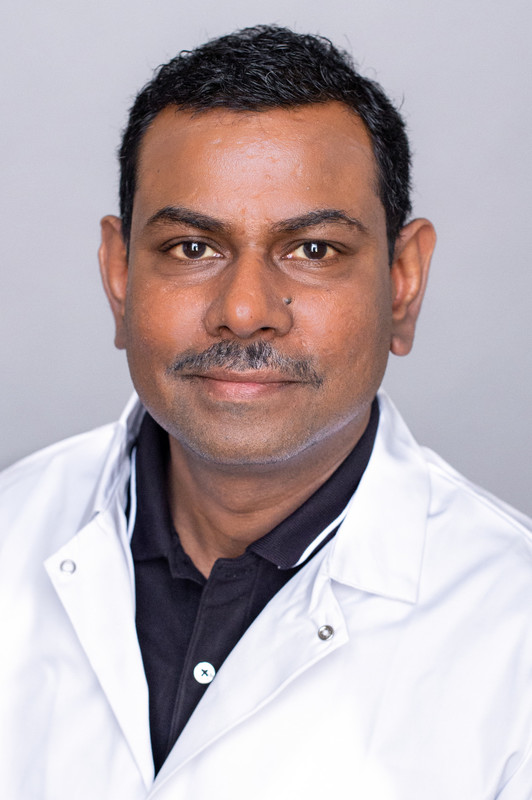Narendra Wajapeyee, Ph.D., a professor in the Department of Biochemistry and Molecular Genetics, and Parmanand Malvi, Ph.D., an instructor in the Department of Biochemistry and Molecular Genetics and the study's first author, have recently been honored with the Heersink School of Medicine's Featured Discovery award. This initiative recognizes significant research contributions from Heersink faculty members. Narendra Wajapeyee, M.D.
Narendra Wajapeyee, M.D.
Their study, “HOXC6 drives a therapeutically targetable pancreatic cancer growth and metastasis pathway by regulating MSK1 and PPP2R2B,” was published in the Cell Reports Medicine Journal.
In this study, Wajapeyee and Malvi investigated pancreatic cancer, one of the deadliest cancers with no effective therapies currently available. Their recent research discovered that targeting the transcription factor Homeobox C6 (HOXC6) can inhibit the cancer's growth. Blocking HOXC6-driven pathways, either alone or in combination with other FDA-approved drugs, presents new therapeutic opportunities for treating pancreatic cancer and offers hope for improved outcomes in patients.
"It was a fascinating experience to work on this study as we conducted our research on pancreatic cancer, which is one of the most lethal cancers with lowest survival rates, and for which effective therapies are not available,” said Malvi. “We have discovered a pharmacologically targetable Achilles' heel across multiple transcriptional subtypes of pancreatic cancer driven by HOXC6-mediated oncogenic pathways."
The Heersink communications team met with Wajapeyee to learn more and spread awareness about the study and the Heersink School of Medicine.
Q: What compelled you to pursue this research?
We were driven by the urgent need to find better treatments for pancreatic cancer, one of the most lethal cancers. Discovering new ways to treat it and improve patient outcomes has been my primary motivation. Also, our laboratory’s focus on transcription regulation was key in designing experiments to selectively identify pancreatic cancer-driving transcription pathways, such as the ones driven by HOXC6.
Q: What was your most unexpected finding?
The most unexpected finding was that targeting HOXC6 inhibited pancreatic cancer across multiple transcriptional subtypes of pancreatic ductal adenocarcinoma (PDAC) by targeting largely common targets.
Q: How do you feel your research will impact the science community?
I believe our research will significantly impact the scientific community by providing new therapeutic targets, such as those driven by HOXC6, for treating pancreatic cancer, potentially leading to improved patient survival. Our findings also pave the way for advancing our understanding and overcoming drug resistance in pancreatic cancer, thus improving patient survival rates and reducing the high mortality associated with this disease.
Q: What is your research’s relevance to human disease?
Our research is highly relevant to human disease as it focuses on pancreatic cancer, one of the most lethal cancers affecting humans. By targeting the HOXC6 targets MSK1 and PPP2R2B that regulate the mTOR pathway, we can develop more effective treatments and potentially improve survival rates for patients battling this aggressive cancer.
Q: When did you know you had an important discovery?
We realized that we had made an important discovery when we observed that targeting HOXC6 not only inhibited tumor growth and metastasis of pancreatic cancer but also significantly enhanced the effectiveness of existing cancer therapies in treating pancreatic cancer in our study models. This breakthrough indicated that the identified targets could serve as a promising new avenue for hard-to-treat pancreatic cancer.
Q: How has being at UAB and living in Birmingham affected your research?
Being at UAB and living in Birmingham has positively impacted my research by providing access to world-class facilities, a collaborative environment, and a supportive academic community. The city's strong focus on biomedical research and innovation has fostered valuable connections and opportunities that have advanced my work on pancreatic cancer.
Q: What made you come to UAB?
I chose to come to UAB because of its outstanding reputation in medical research and its cutting-edge facilities. The opportunity to work with leading experts in the field of cancer research and the supportive, collaborative environment at UAB were significant factors in my decision.
Q: What do you find makes the science community here unique?
The science community at UAB is unique due to its strong emphasis on interdisciplinary collaboration, which fosters innovative approaches to research. Additionally, the supportive environment and access to state-of-the-art resources enable scientists to push the boundaries of their respective fields.